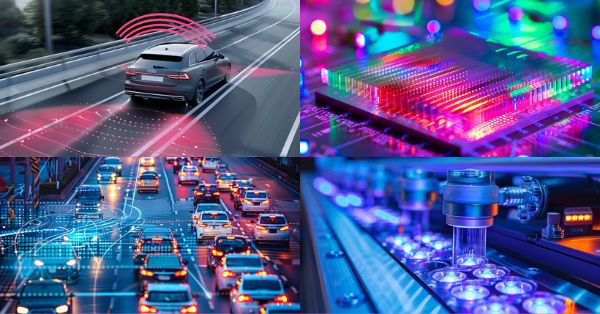Apr. 9, 2024

SWIR Imaging
Colloidal Quantum Dot (CQD) technology is revolutionizing shortwave infrared (SWIR) sensing, offering a scalable, cost-effective alternative to traditional InGaAs sensors. This article outlines the evolution of CQD SWIR sensors from their initial challenges to current achievements and future prospects. Emphasizing a wafer-level fabrication approach, CQD technology enables high-resolution sensors at reduced costs, making SWIR sensing accessible for new industrial applications. We highlight the technology's adaptability with various ROIC designs, enhancing pixel resolution capabilities. Recent advancements have improved sensor reliability, meeting automotive standards and undergoing space-grade radiation testing. The collaboration with the Army on an ALPD-capable sensor underscores CQD's potential in defense and beyond. Despite current limitations like lower quantum efficiency compared to InGaAs, ongoing research promises significant enhancements. The integration with SWIR-optimized systems, including optics and illumination, is crucial for maximizing performance. Looking ahead, CQD SWIR technology's scalability and cost reduction could mirror CMOS sensor success, expanding its use in automotive and consumer electronics.
Key Technologies: Quantum dots, InGaAs sensors, CMOS sensors, SWIR
Transportation/Traffic
As the cost of vision systems drop and their performance rises – thanks to better sensors and the implementation of AI – cities and regional governments are using the technology for traffic monitoring, yielding significant benefits. The ability to count and classify vehicles, for instance, can help keep today’s traffic moving and ensure more accurate planning to meet tomorrow’s transportation needs. Continued progress in traffic monitoring technology, though, may require better AI models and training, the use of new imaging spectrum and modalities, and other innovations. If that happens, look for better data about what’s on the road and where it’s headed to continue to decrease congestion, make people happier, and cut traffic’s carbon footprint.
Key Technologies: sensors, AI
Machine Vision Lights Boost Canning Line Inspection Speeds
Machine vision is increasingly important for companies not only navigating labor shortages but also trying to stay competitive in an ever-evolving global economy. In areas such as food and beverage inspection, for example, the machine vision vendor community must innovate to keep pace with evolving production processes and faster line rates. Typically comprised of cameras, cables, lenses, industrial computers, and software, machine vision systems, like those for high-speed 360-degree can and bottle inspection, cannot “see” without lighting. Systems that do this job have existed for some time, but companies looking to increase throughput while maintaining accuracy require innovative lighting designs. Specifically, for software to perform inspections, cameras need to acquire quality images, a process that relies on good lighting.
Key Technologies: lighting
Sub-pixel High Dynamic Range Imaging
High Dynamic Range (HDR) technology makes it possible to capture images with exceptional clarity, preserving details in bright and dark regions. However, the quest for advancements in this domain led to the emergence of sub-pixel HDR technology. This cutting-edge innovation takes HDR imaging to new heights, empowering sectors like Advanced Driver Assistance Systems (ADAS), autonomous mobile robots and autonomous vehicles. Sub-pixel HDR technology, also known as split-pixel HDR technology, plays a crucial role by allowing camera systems to capture and reproduce a broader range of brightness levels. Referred to as sub-pixel HDR, it involves dividing each pixel on the sensor into two sub-pixels to capture brighter and darker areas simultaneously. So, the highlighted pixel makes sure that details in the brighter areas of the scene are captured. The shadow pixel ensures that details in the darker areas are captured. This reduces motion blur and produces vibrant, lifelike images with accurate color representation.
In comparison, multi-exposure or traditional HDR leverages short and long exposures to capture a wide range of brightness levels (brightest highlights to darkest shadows, respectively) in a single image. Then, the multiple exposures are merged using algorithms, delivering a final HDR image. Hence, traditional HDR relies on multiple exposures and post-processing, making it more time-consuming and potentially introducing artifacts in high-motion scenarios.
How sub-pixel HDR technology works
Each pixel in the sensor is composed of two types of on-chip lenses (OCL): one large and one small. The smaller lens is situated within the space of the larger one. This design allows for one pixel that captures dark scenes with high sensitivity and another that resists oversaturation in bright scenes.
Key Technologies: HDR cameras, autonomous vehicles, mobile robots
Download Media Planner